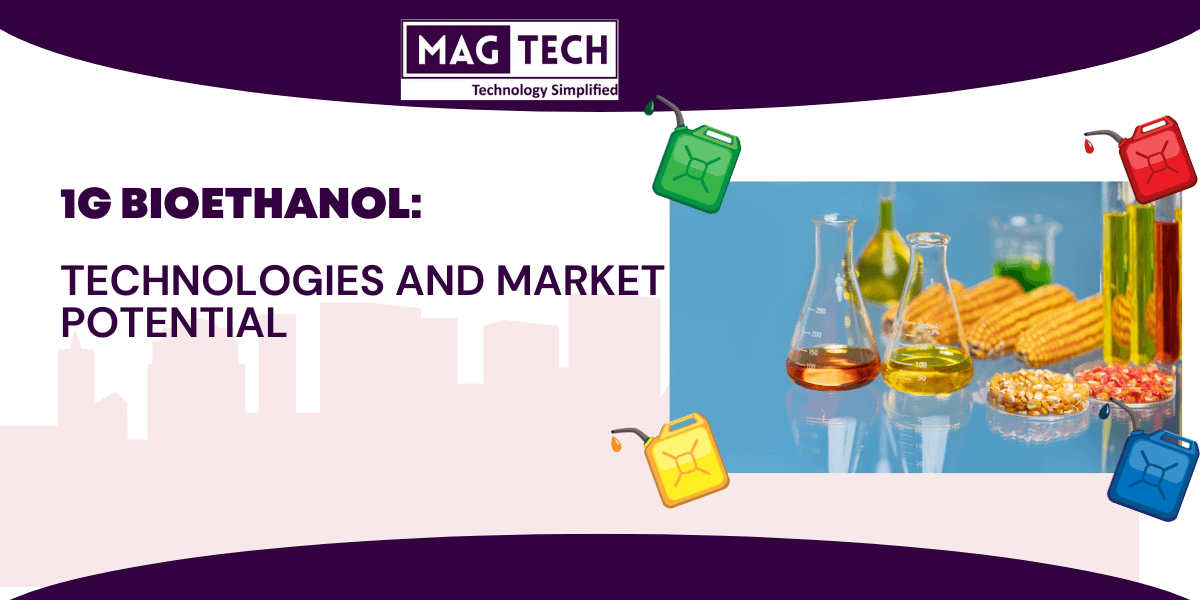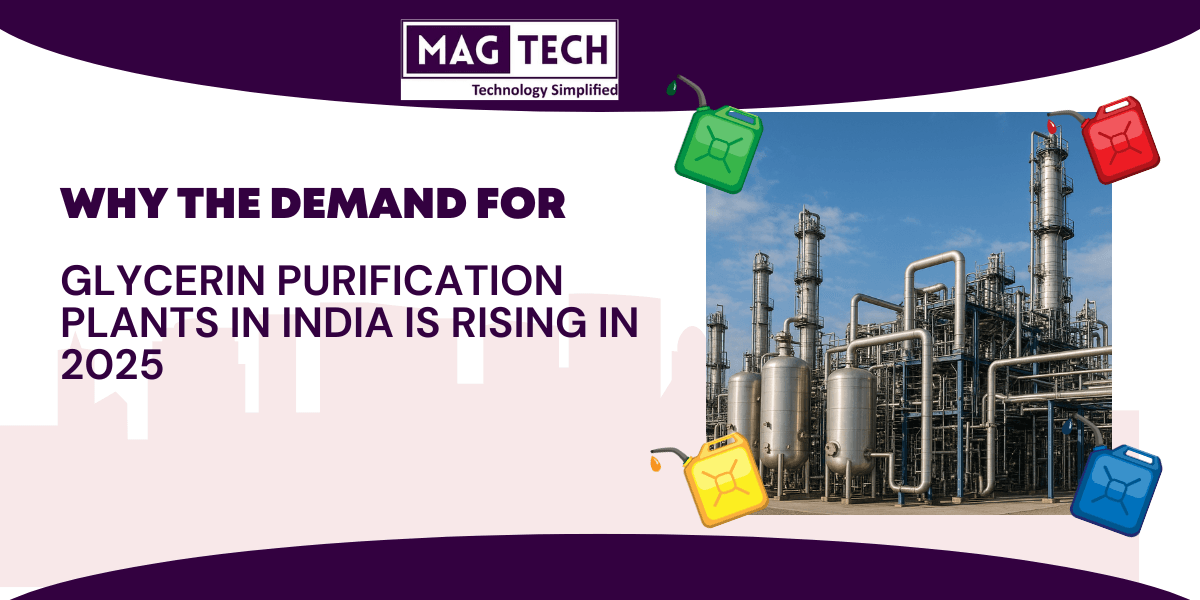Glycerin, chemically known as glycerol, is a byproduct of biodiesel manufacturing. This organic compound is sweet and has no odor. This biochemical compound is used for diverse applications across many industries. Its global market revenue is expected to reach US$ 5.18 Billion by the end of 2030, growing at a CAGR of 7.23% (2024 – 2030). This substantial growth is supported by contemporary drivers, such as, on the one hand, focusing on personal care, pharmaceuticals, nutraceuticals, and industrials; on the other hand, it also includes food and beverages, etc. This is a major opportunity for biodiesel manufacturers to monetize this byproduct and support the global glycerin demand. So, to understand its economic impact, let us scout the diverse range of glycerin products used in different industries.
Table of Contents
ToggleRange of Glycerin Products and Their Uses
Glycerin, available in both crude and refined forms, is a versatile product valued across multiple industries. Crude glycerin is typically a byproduct of biodiesel production. Refined glycerin, therefore, undergoes purification to meet high standards for cosmetics, pharmaceuticals, and food applications. Let us take a look at the glycerin products used in various industries.
1. Cosmetics and Personal Care:
- Polyglycerol Esters: Used as emulsifiers and stabilizers in lotions, creams, and shampoos, adding smoothness and consistency.
- Dihydroxyacetone (DHA): Commonly found in self-tanning products, giving skin a natural, sun-kissed appearance.
- Glyceric Acid: Added to skincare items for hydration and softness, improving texture and moisture retention.
- Hyperbranched Polyesters: Provides stability and conditioning; consequently, it enhances product quality in creams and hair care formulations.
2. Food and Beverage:
- Succinic Acid: Acts as an acidity regulator and flavor enhancer in processed foods, helping to extend shelf life.
- Polyglycerol Esters: Employed to improve texture and consistency in products like dressings, margarine, and baked goods.
- Dihydroxyacetone (DHA): Functions as a flavoring and preservative, maintaining freshness in food items.
- Glyceric Acid: An additive that smooths flavors and enhances mouthfeel in various food products.
3. Pharmaceuticals:
- Glyceric Acid: Used in skin lotions and ointments for hydration and improved skin texture.
- Succinic Acid: Important in the production of certain drugs, acting as an intermediate in synthesis.
- Hyperbranched Polyesters: Applied in drug delivery systems, improving the solubility and effectiveness of treatments.
- Polyglycerol Esters: Serve as excipients, assisting with drug formulation and stability.
4. Renewable Energy and Green Chemistry:
- Propanediol (1,3-PD): Key in producing polytrimethylene terephthalate (PTT) for textiles and durable plastics, as well as in green solvents and adhesives.
- Crude Glycerin for Hydrogen Production: Converted into hydrogen fuel, supporting renewable energy goals and clean fuel technologies.
- Energy Production from Crude Glycerin: Used in boilers or, in addition, combined with biomass for energy generation, thereby providing a sustainable alternative to fossil fuels.
- Biogas Production: Glycerin co-digested with organic waste enhances biogas yields, creating renewable energy sources from waste materials.
5. Agriculture and Animal Feed:
- Crude Glycerin as Livestock Feed: Approved for animal feed in limited amounts, providing an energy source for livestock like pigs, hens, and cattle.
- Dust Control: Applied to unpaved roads and work sites to reduce dust emissions and particulate pollution; consequently, this creates safer, cleaner environments.
6. Textile and Manufacturing:
- Propanediol (1,3-PD): Essential in producing durable polymers for textiles and carpets, contributing to sustainable manufacturing practices.
- Polyhydroxyalkanoates (PHA): Biodegradable plastics created from glycerin, therefore, serve as effective alternatives in textile packaging, consequently reducing plastic waste.
- Hyperbranched Polyesters: Used in coatings and adhesives, adding flexibility, durability, and environmental benefits to manufactured goods.
7. Medical and Healthcare:
- Polyhydroxyalkanoates (PHA): Used in the production of biodegradable sutures, drug delivery systems, and tissue scaffolding, enabling safer, biocompatible solutions.
- Hyperbranched Polyesters: Furthermore, it enhances the delivery and solubility of drugs, thereby increasing treatment efficacy for patients.
- Polyglycerol Esters: Used as stabilizers in formulations, ensuring product consistency and effectiveness.
8. Automotive and Industrial Applications:
- Polyhydroxyalkanoates (PHA): Eco-friendly plastics replace traditional materials in automotive parts, consequently promoting sustainability.
- Hyperbranched Polyesters: Enhances coatings and adhesives for industrial use, improving flexibility, adhesion, and environmental performance.
9. Environmental and Waste Management:
- Crude Glycerin in Wastewater Treatment: Provides a carbon source for microbial activity; consequently, it helps to process wastewater and reduce organic pollutants.
- Dust Control Applications: Applied to dirt roads and construction sites to minimize dust and particulate emissions, maintaining cleaner work environments.
10. Biodegradable Packaging and Plastics:
- Polyhydroxyalkanoates (PHA): As biodegradable plastics, PHAs, therefore, find application in packaging, single-use items, and agricultural films, thus supporting sustainable waste management.
- Succinic Acid in Biodegradable Polyesters: Forms the basis for biodegradable packaging materials; consequently, it contributes to waste reduction efforts in various sectors.
Each form of glycerin products has unique properties and uses, tailored to specific industry needs. In cosmetics, refined glycerin provides hydration and smooth texture, while in energy and agriculture, crude glycerin serves as an efficient feedstock and fuel alternative. This adaptability makes glycerin an essential component in sectors ranging from personal care and pharmaceuticals to renewable energy and animal feed.
Other Key Market Drivers Increasing Glycerin Consumption!
The other glycerin products or uses are the emerging key market drivers that are contributing to glycerin consumption globally are:
- E-Cigarette Industry:
The e-cigarette industry has become a key driver for glycerol demand; consequently, glycerol is widely used in e-liquids.Its ability to create a smooth vapor makes it essential for vaping products. The rising global popularity of e-cigarettes, consequently, directly increases glycerol consumption, thereby making this sector significant for market growth.
- Textile Industry:
In textiles, glycerol is used as a softening agent, adding flexibility and comfort to fabrics. This demand for softer, more comfortable materials, consequently, positions glycerol as a valuable additive, thereby expanding its role in textile manufacturing.
- Healthcare Industry:
Glycerol’s presence in pharmaceuticals, such as suppositories and injectables, highlights its importance in healthcare. It aids in various medical preparations, especially those for rectal and oral administration, strengthening its value in medical applications.
- Polyurethane and Polyols:
Glycerol serves as a primary raw material in polyols; consequently, it is essential for making polyurethane foams used in furniture, insulation, and automotive products. Furthermore, its role in these products contributes to its steady demand.
- Bio-Based Chemicals and 3D Printing:
In sustainable chemistry, glycerol is, therefore, central to producing bio-based chemicals and solvents; thus, it aligns with the eco-friendly movement. Glycerol-based formulations are also gaining attention in 3D printing as biodegradable printing materials, further boosting its market appeal.
New windows of opportunities open up for glycerin manufacturers. Biodiesel production holds the highest market share of glycerin manufacturing worldwide. Biodiesel producers, therefore, enjoy these new and existing key market drivers for generating more revenue from glycerol, the major byproduct of biodiesel. The recent developments in this market have, consequently, had a significant impact on the production and supply of glycerin worldwide.
Impact of Technology on Glycerin Production:
These recent developments, therefore, play a key role in driving the production and purification of glycerin to meet the increasing demands.
- Membrane Technology:
This technology is used to separate and purify glycerin; consequently, it selectively isolates it from other reaction components. It not only reduces the need for multiple purification steps but also cuts down costs and improves efficiency.
- Continuous Processing Systems:
Moving from batch to continuous processing has, consequently, enhanced control over production parameters, thereby ensuring consistent quality and, in turn, higher output. This shift leads to better scalability and overall production efficiency.
- Biocatalysis:
Enzyme use in glycerin production reduces unwanted by-products and lowers energy consumption. This approach, therefore, increases selectivity in reactions, which ultimately makes production more efficient and, consequently, eco-friendly.
- Supercritical Fluid Extraction (SFE):
Utilizing carbon dioxide in supercritical fluid extraction, therefore, enables glycerin production at lower temperatures and pressures; as a result, it cuts energy use and, in addition, avoids harmful solvents.
- Advanced Distillation Techniques:
Vacuum and molecular distillation methods, therefore, purify glycerin at reduced temperatures, consequently preserving quality and minimizing degradation, which is, in fact, crucial for high-end applications.
- Automation and Digitalization:
Digital technology integration in glycerin plants allows for real-time monitoring and precise control, enhancing both safety and production efficiency through better data analysis.
- Green Chemistry and Sustainable Feedstocks:
Green chemistry principles guide the use of renewable feedstocks and safer production methods, while research into sustainable sources, like algae, creates eco-friendly production options.
- Nanotechnology for Purification:
Furthermore, nanofiltration and nano-adsorbents offer highly selective, efficient purification; consequently, they advance glycerin’s purity levels and, in turn, make production more cost-effective.
- Waste-to-Energy Technologies:
Converting production waste into energy or valuable by-products not only minimizes the environmental impact of glycerin extraction but also adds revenue streams and reduces waste.
Adopting these innovations, therefore, allows biodiesel producers to increase profitability through efficient, sustainable glycerin production; consequently, they can meet market demand with lower costs.
Explore New Profitable Spheres with Glycerin Production!
Biodiesel producers stand to gain significantly from glycerin production, as glycerin is a valuable byproduct of the biodiesel manufacturing process. As the global glycerin market grows, consequently, biodiesel producers can capitalize on this demand in several ways.
- Diverse Applications:
Glycerin has a wide range of uses across various industries, including cosmetics, pharmaceuticals, food and beverages, and renewable energy. This versatility enhances its marketability. For instance, in cosmetics, glycerin acts as an emulsifier and moisturizer, while in pharmaceuticals, it serves as a stabilizer in drug formulations. By producing glycerin, biodiesel manufacturers can tap into these lucrative markets.
- Cost Efficiency:
Advances in technology, such as membrane technology and continuous processing systems, allow for more efficient glycerin extraction and purification. These innovations reduce production costs and improve overall yield. As glycerin production becomes more cost-effective, biodiesel producers can increase their profit margins.
- Sustainable Practices:
The incorporation of green chemistry principles and, furthermore, the use of sustainable feedstocks, such as algae or waste cooking oil, not only align with the growing demand for eco-friendly products but also contribute to a more sustainable future. Biodiesel producers that embrace these methods, consequently, can enhance their brand image and, in turn, appeal to environmentally conscious consumers.
- Revenue Generation:
As biodiesel production often yields crude glycerin, biodiesel producers can sell this byproduct to various sectors. This additional revenue stream can help offset production costs; consequently, it allows for a more profitable operation.
- Waste Management:
By utilizing waste-to-energy technologies, biodiesel producers can, in fact, convert production waste into energy or, alternatively, valuable chemicals. This not only minimizes environmental impact but also creates further revenue opportunities.
However, the challenges of integrating glycerin extraction and purification units with biodiesel production setups need expertise. If done correctly, biodiesel producers can benefit from glycerin production by expanding their market reach, reducing costs, adopting sustainable practices, and creating additional revenue streams.
Add Glycerin Production Advantage to Your Biodiesel Manufacturing with MAGTECH!
By partnering with MAGTECH, the leading glycerin purification solution provider, you can, therefore, optimize your glycerin production process. Our advanced solutions ensure efficient glycerin extraction and purification and enable you to meet market demands while minimizing costs.
Harness the potential of glycerin products’ markets worldwide with biodiesel production; consequently, generate more revenue. Contact MAGTECH today to learn how we can help you maximize your glycerin profits and support your sustainable business goals.
Ref URLs:
https://biodieselmagazine.com/articles/glycerin-research-turns-up-new-uses-3237
https://www.verywellhealth.com/glycerin-7499424
https://www.volza.com/p/refined-glycerine/export/export-from-india
https://www.lucintel.com/glycerin-market.aspx
https://www.emergenresearch.com/industry-report/glycerin-market


